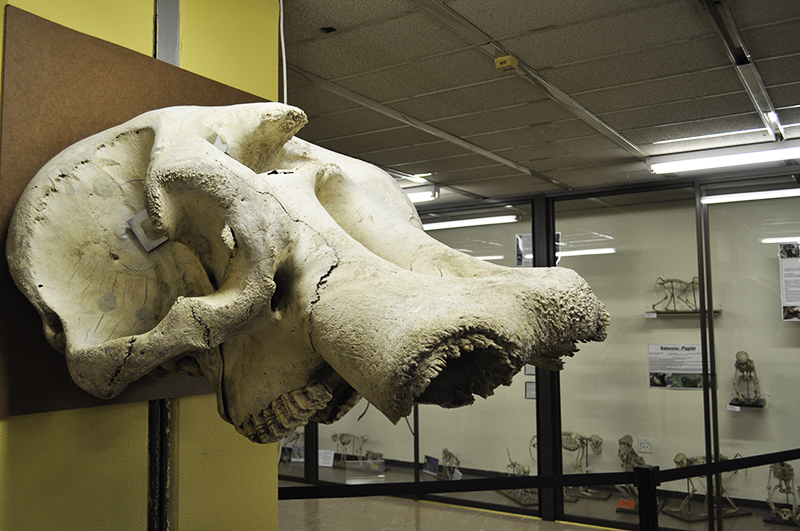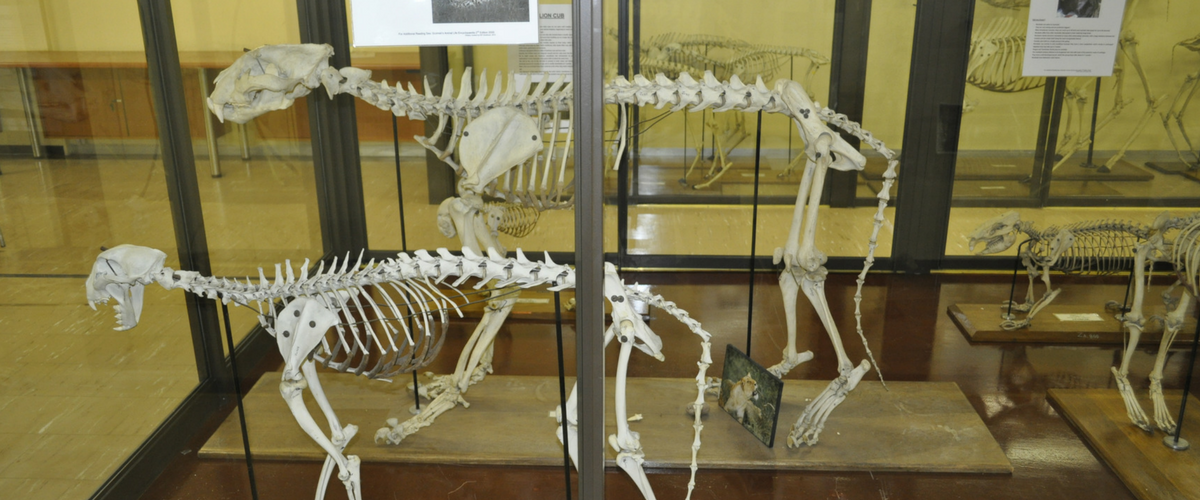
The Hunterian Museum
The Hunterian Museum, housed in the School of Anatomical Sciences based in the Faculty of Health Sciences, is a unique collection consisting of human and non-human anatomical exhibits.
The anatomical specimens housed within this collection cater to a multitude of students in their respective disciplines as a supplementary aid for their studies. Historically, the Museum was initiated by the efforts of Prof Raymond A. Dart in 1923 who was inspired by the prominent surgeons, the Hunter brothers, who developed the original Hunterian Museum and Collections in Glasgow and London. The collection includes a wide range of human and comparative non-human anatomical and pathological specimens.
The human specimens are subdivided into theme-specific cubicles that cover a wide range of anatomical regions, in the form of osteological remains, plastinated cadaveric specimens and bottled specimens. The animal collection within the Museum displays a varied array of articulated skeletons of Mammalian, Reptilian, Avian and select Marine life. The Museum and its related holdings include extensive collections (most of which are not on display) of human and comparative specimens. Other collections maintained in the School of Anatomical Sciences, and related to the Hunterian Museum through teaching or research; include the R.A. Dart Collection of Human Skeletons, the Comparative Faunal Osteology Collection; Life and Death Mask Collection as well as the Anatomical Pathological Collection.
The Raymond A. Dart Collection of Human Skeletons is one of the largest collections of modern human skeletal remains in the world, and the largest in Africa, including almost 3000 unique individuals with known demographics.
Follow the links below for more information on this collection:
- https://doi.org/10.1002/ajpa.21072
- https://www.wits.ac.za/campus-life/arts-and-culture/the-hunterian-museum-of-anatomy/raymond-dart/
The Life and Death Mask Collection is the most comprehensive facemask collection in Africa with an estimated number that exceeds 1000 masks. The facemask collection in particular is of a sensitive nature due to its infamous history, nevertheless it remains an exemplary representation of humanity’s vast and beautiful biodiversity, and as a School we commemorate the lives of those whose faces are represented.
Follow the link below for more information on this Collection:
https://doi.org/10.1016/j.jchb.2017.08.004
The Museum is continually augmented with teaching and research materials. The most recent addition to the Museum specifically showcases a variety of fascinating human pathologies which are rarely observed outside of the surgical setting. The arrangement of these bottled specimens, includes detailed descriptions from the original surgeons who operated on these patients, as well as comprehensive information pertaining to these pathological processes, to aid the students’ understanding. The pathologies range from the more common gall stones and skin cancers to rare and extreme pathologies such amoebiasis of the liver and cerebral tuberculoma to name a few. These specimens come from a recent addition to the collections, the Pathological Bottled Specimen Collection, which spans over 400 individual cases donated to the School from the Surgery Department of Wits.
The Museum has the additional function of providing tours to Secondary School learners and other educational institutions which can be arranged by appointment with the School. Through these tours we hope to attract and peak the youth’s interest in anatomy by allowing them to gain an insight and be inspired by the wonderful world of the anatomical sciences. The School has a rich history of prominent scientists, researchers, and medical professionals, who greatly contributed to the creation, improvement and management of the collections described. Hopefully these contributions can someday add value to the future professionals that use this irreplaceable repository.
Most significantly the School would like to dedicate a special vote of thanks to all the individuals who unselfishly donated their remains towards the establishment of these collections to assist future learners in their studies and scientists in their pursuit of knowledge.
The School has a strict policy pertaining to the treatment of the remains housed within the Museum. All staff, students and visitors are expected to act in an ethical manner with the utmost respect in the process of viewing all Museum exhibits. For this reason, the following regulations are in place:
- Any form of audio-visual recording is absolutely not allowed
- Food and drink are not permitted on the premises
- Any form of bags are not allowed in the Museum area
- Handling any of the remains is limited to registered students and staff, and is to be carried out with extreme care
- Moving any specimens out of their respective displays or cubicles is strictly prohibited
Failure to abide by the set rules and regulations could lead to disciplinary action and or the termination of any future visitations.
The Museum is situated on the Second Floor of Wits Medical School, 7 York Road, Parktown, Johannesburg.
For more information regarding the Hunterian Museum please contact the Chair of the Collections committee:
Telephone: (011) 717-2057; fax: (011) 717-2422;
E-mail: Brendon.Billings@wits.ac.za






